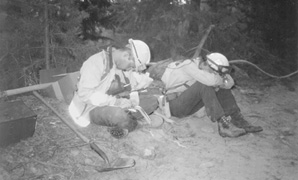
Dock of the Bay

Volume VI Number 27
July 9-15, 1998
Campaign Trail - Evans: Gary 'Threats, Intimidation' Rule Schools
Anne Arundel councilwoman and county executive candidate Diane Evans, below.
To hear Diane Evans tell it, County Executive John
Gary could use a class or two in charm school -- not to mention a public
administration course -- to better oversee Anne Arundel County schools.
Gary replies he may be a tad gruff, but that's what it may take to rein in an out-of-control school board.
It's getting about time to decide who's right. With his demand for a state audit, Gary shows no signs of lightening up on the school board. And Evans is grabbing education issues at every juncture as she seeks traction in her campaign to unseat Gary in November.
With the still-painful blow of $9 million in cuts -- cuts that will impose $50 "sport fees" on high school athletes, end gifted and talented and programs and slash after-school bus service --- education is shaping up as a pivotal issue in the long-awaited Evans-Gary showdown.
Of course Evans, the Republican-turned-Democratic county council member, first must survive her new party primary in September. But she's looking ahead to Gary right now, questioning his judgment and his style in his on-going battle with county school officials.
"Mr. Gary's bullying tactics have produced a stalemate with schools," Evans said in an interview.
Evans has promised to increase county spending on schools by at least 4 percent in her first year as county executive, with emphasis on school maintenance. While the dollar amount of school expenditures has increased, the percentage of the county money devoted to education has dropped since Gary took office in 1995, Evans asserts.
This week, Evans introduced a resolution in the county council aimed at forcing the release even sooner of county money for schools. She also has been critical of Gary's recent demand for a state audit of school board expenditures.
"Everywhere I've been throughout the county, people are angry. They're confused. They're frustrated. They're anxious," Evans said. "They don't understand why the county executive has developed such hostility toward the school system, and they want an end to it."
Lisa Ritter, Gary's spokeswoman, asserts that the point should not be lost that Gary's administration hiked school spending this year by $14 million before the $9 million in cuts were imposed by the board.
"I think he's misunderstood. It's easy to see this as an attack on education when, in reality, it's an attack on bureaucracy," she said. "He wants the money to go into classrooms, into education, not into overhead."
Gary's long frustration with the school board is no secret; nor is his gruff exterior and occasional public anger. But while some might call Gary belligerent, Ritter sees Gary as being decisive in an important matter of public policy.
"To some extent, there's a focus on John's style, in terms of being a little hard-hitting and confrontational. That's unfortunate because it detracts from the substance of his message," she said.
For Evans, Gary's hard-edged approach to policy issues - especially those that may seem outside his control - is a self-defeating method of operating that has no place in county government. The quiet, often reticent Evans appears set on making the November election a choice not just of policies but also of personality.
"He uses these tactics whenever anyone challenges him or questions his positions. Bullying tactics do not work. They are no way for people in leadership positions to solve problems," she said.
-BL
For These Marylanders, Fireworks in Florida No Vacation
Helping combat out-of-state blazes leaves DNR forester-firefighters in need of rest. photo courtesy of Will Williams
Remember how your trees and shrubs, your vines and
grasses went wild this rainy spring? Now imagine that after that lush growth,
the rain stopped dead - three months ago. Raise the temperature until the
thermometer says 100 ,
and you've got trouble brewing.
,
and you've got trouble brewing.
Next float some thunderheads into the picture, but instead of the rain you long for, they shoot bolts of lighting at the earth's tinder.
Whoosh goes the red-orange flame, and it's running, sizzling along the ground, evaporating groundcover and shrubs, climbing trunks, rushing down limbs, leaping from treetop to treetop.
That's the kind of fireworks that occupied 16 elite firefighting Marylanders over the Fourth of July.
The Maryland Department of Natural Resources forest rangers joined an eventual force of nearly 6,000 firefighters from Florida and 44 other states in quelling the wind-whipped, raging flames destroying vast swaths in the northern part of the state. So far, a half-million acres have burned.
"Our crew has been right in thick of things," said Maryland forest ranger Will Williams of St. Mary's County. Maryland DNR foresters are trained firefighters who respond to National Forest Service calls for help all over the country.
When DNR's first dozen and a half firefighters left on this mission, fires were edging too close to towns like Daytona, Titusville, Mims, Wakulla Springs, De Land and Ormond Beach. Nearly every part of Florida except the Keys has been plagued by the drought and fires that followed.
You can see smoke from 30,000 feet up in a jet, where the cloud layer is blue-black with soot, like snow lying over a very dirty city. Lower down, the air is thick with smoke and ash, and five or six feet above the ground, people feel the fire, feel it on their skins and in their lungs.
"Under a baleful amber sun, ashes gently sifted down from a leaden sky across a gigantic swath of Florida's east coast as huge, angry wildfires menaced Central Florida," Miami Herald reporter Michael Browning wrote Friday, July 3.
These are the scenes that Maryland firefighters know first hand.
Since June 6, DNR forest rangers have been putting themselves up against one or another of Florida's 1,700 fires. Floridians have seen so many fires that they're giving them names such as the Holiday Fire, which broke out near Wakulla Springs.
In one of DNR's internal memos, on-the-scene Maryland ranger Rick Lillard called the Florida fires "the most intensive burning" he has ever seen. Lillard has spent many summers fighting fires in Western states.
Maryland sent not only firefighters but also engines, plows, water trailers, and tractors. Among DNR's engine task force finishing two weeks of duty near Bunnell, between St. Augustine and Daytona Beach, is Calvert County ranger Tim Stanley.
On July 1, Maryland DNR fire supervisor Alan Zentz captured the intensity of the blaze in a memo. "Our personnel are working in some of the most extreme burning conditions they have ever seen, which include temps in the 100s, gusty/strong winds, drought-stressed vegetation, smoke and flashy fuels," he wrote.
Firefighters on the scene called it "one of the most challenging Maryland personnel have been given the opportunity to work on," Zentz wrote.
Some days they won; other days they lost.
Near Daytona - where NASCAR racing was postponed until October - a three-mile-long fire front crossed I-95 on July 1, and fire closed 145 miles of the highway. On the scene, Maryland task force leader Bob Hartlove reported "countless businesses and homes destroyed or on fire."
But that night, protecting a federal prison, the Maryland force held the line on their fire line.
The next day, July 2, Gov. Parris Glendening added to the DNR contingent, mobilizing 150 Maryland professional and volunteer firefighters under the nationwide Emergency Management Assistance Compact. Twelve counties and Ocean City sent firefighters and equipment, with Calvert County sending a dozen fire fighters and three trucks.
By July 5, whole counties were evacuated; 1,800 people were living in shelters; more than 200 homes and businesses were destroyed or damaged. But the tide was turning, with favorable sea breezes, rain - and nearly 200 Marylanders joining the fray.
By July 9, DNR's first crew returned home, but a second crew - including Anne Arundel County forester Bud Reaves and Calvert County forester Steve Stadelman - continued the battle.
"The danger is far from over, but the crews seem to be gaining the upper hand," said Williams.
-SOM
Watershed Grants Help Save the
Bay
Planting native grasses in wetlands helps save the Bay.
We have the will. We have the way. We need the money.
Which is on its way. Once again this year, Congress has done right by the Bay, giving the Chesapeake Bay Program nearly everything it sought. Federal lawmakers -- whose largess may be explained by the fact that they come here to boat and play -- are sending money to the Environmental Protection Agency for volunteer groups throughout Chesapeake Country, thus bolstering local efforts to save our beloved Bay.
"The key to success in restoring the Chesapeake is local action, helping individuals and their communities to do their part all across the watershed," attests EPA's regional administrator W. Michael McCabe.
In keeping with this philosophy, the EPA's Chesapeake Bay Program is awarding $650,000 in new Small Watersheds Grants to community programs across the Bay region. Groups from Maryland, Pennsylvania, Virginia and D.C. say they'll use the money for projects ranging from stenciling "Chesapeake Bay Drainage" on storm sewer intakes to collecting hazardous wastes and preserving habitat for wildlife.
The power of money will be soon seen in our area. Of 15 Maryland projects funded, five touch the waters of Southern Maryland. Grateful winners include:
The lucky organizations to receive the funds are, for good reason, celebrating. Only 37 of 160 applicants won funding for their projects.
Figures like that mean lots of people eager to see the grants program continue. "We're hoping that we'll have funding again next year for this program," said Bay Program's Mindy LeMoine.
In other words: hey Congress, don't forget us next year.
-Mark Burns
Virginia landfills have doubled to 3.2 million tons yearly their import of out-of-state trash for burning or burial, according to the state's Department of Environmental Quality. Virginia is now second only to Pennsylvania, which took in 5.2 million tons last year
In Washington, the Nuclear Regulatory Commission has decided to urge states and communities near nuclear power plants to stockpile potassium iodide to protect residents in the event of a nuclear accident. The capsules block the thyroid's intake of radioactive iodine if taken shortly after exposure to radiation. The nuclear industry tried to block the stockpiling, arguing that it would heighten safety concerns
In the Pacific Northwest, every time you tip a Wild Salmon Pale Ale you are saving a fish. Fish Brewing Co. of Olympia, Wash., is donating a dime from each case sold and $2 from each keg to support the work of the Save Our Wild Salmon organization, the Seattle Daily Journal of Commerce reports ...
In California, the three-wheel, electric
motorcycle known as the Sparrow is taking off. The fu lly enclosed
vehicle, which can travel 60 miles on a single charge, received an endorsement
from famed Hell's Angel leader Sonny Barger: "I only drive the
Harley because I'm in the club. This Sparrow, man, it's the wave of the
future" ...
lly enclosed
vehicle, which can travel 60 miles on a single charge, received an endorsement
from famed Hell's Angel leader Sonny Barger: "I only drive the
Harley because I'm in the club. This Sparrow, man, it's the wave of the
future" ...
California is the venue for another crackdown on jet skis. The California Air Resources Board last week proposed new air pollution rules governing wave runners after determining that the emissions from a single jet ski engine in two hours are equivalent to pollution from a 1998 car operated for 130,000 miles, the San Francisco Chronicle reported this week ...
Our Creature Feature comes from Texas, where it would seem that red hawks have been enlisted in the anti-smoking crusades.
For two months, the federally protected hawks took turns attacking workers trying to whitewash Marlboro billboards beneath their nests at Texas Stadium in Irving, near Dallas. Finally, the Marlboro Man won: Workers now are allowed to drive off the birds with air horns.
| Back to Archives |
Volume VI Number 27
July 9-15, 1998
New Bay Times
| Homepage |